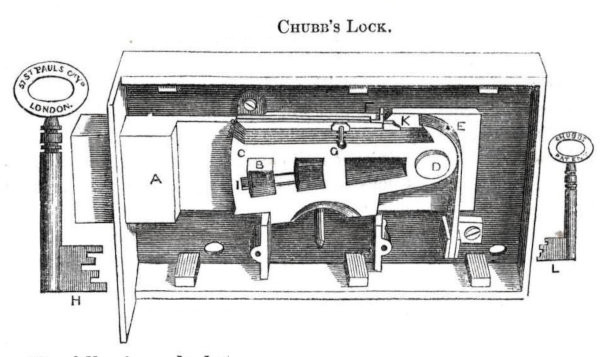In the locksmithing and security world, one individual shines as a symbol of innovation and craftsmanship—Jeremiah Chubb.
Born in 1793 in Fordingbridge, Hampshire, England, Chubb left an indelible mark on the world of locks through his groundbreaking invention, the detector lock. This exceptional creation emerged as a result of a Government competition aimed at crafting a lock impervious to picking, and remarkably, it held its ground against even the most skilled lockpickers for over three decades.
Jeremiah Chubb & The Detector Lock

The Origin of the Detector Lock
The year was 1818, and the British Government had presented an unusual challenge to locksmiths: create a lock that could resist any attempt at picking or tampering. Jeremiah Chubb, a proficient locksmith with a penchant for innovation, embraced this challenge wholeheartedly. What he would ultimately create would revolutionize the landscape of lock security.
Chubb’s design, known as the “detector lock,” was nothing short of brilliant. Its intricate mechanism comprised an array of levers and tumblers, meticulously arranged to construct a complex web of security layers. The essence of the detector lock lay in its capability to detect tampering and respond with unparalleled resilience.
The detector lock jammed when someone tried to open it, thus making it obvious that it has been interfered with. His brother Charles founds the Chubb lock company, which still exists today.
The Unpickable Enigma
One of the most striking characteristics of Chubb’s detector lock was its uncanny ability to foil even the most adept lockpickers. For over three decades, spanning from 1818 to 1851, this lock remained immune to all attempts at picking or tampering. The Chubb detector lock stood as the pinnacle of tumbler lock security—a testament to Jeremiah Chubb’s unparalleled locksmithing expertise.
A Lock That Resisted Tampering
The Chubb detector lock was not a static security device; it possessed a dynamic response to tampering. When anyone endeavored to pick or tamper with this lock using an incorrect key or any unauthorized means, it responded decisively. Instead of yielding to tampering, the lock would immobilize itself in a locked state, making it inoperable.
Unlocking a Chubb detector lock necessitated the use of either a specialized regulator key, meticulously designed to reset the lock, or the original key. This innovative response to tampering rendered the Chubb detector lock a true masterpiece of security engineering.
The Evolution of Excellence
In 1820, Jeremiah Chubb, in collaboration with his brother Charles Chubb, further refined the design of their original lock. This enhanced version no longer relied on a regulator key for reset after an attempted breach without the correct key. Furthermore, the number of lever tumblers was increased to six, fortifying the lock’s security even further.
This improved design, recognized as the “combined Bramah-Chubb lock,” solidified Jeremiah Chubb’s legacy as a pioneer in locksmithing. His creations not only established new benchmarks for lock security but also laid the groundwork for future innovations in the field.
An Everlasting Legacy
Jeremiah Chubb’s contributions to locksmithing and security persist as a testament to human ingenuity and a dedication to safeguarding what matters most. The detector lock and its subsequent iterations continue to inspire locksmiths and security experts today, serving as a reminder that in the pursuit of safety and protection, innovation knows no bounds. Jeremiah Chubb’s legacy endures in every secure door and protected asset, a homage to a locksmithing luminary whose work remains impervious to the passage of time.
